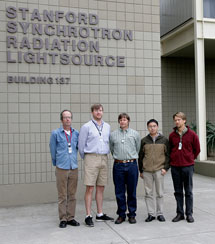
Handy Links
SLAC News Center
SLAC Today
- Subscribe
- Archives: Feb 2006-May 20, 2011
- Archives: May 23, 2011 and later
- Submit Feedback or Story Ideas
- About SLAC Today
SLAC News
Lab News
- Interactions
- Lightsources.org
- ILC NewsLine
- Int'l Science Grid This Week
- Fermilab Today
- Berkeley Lab News
- @brookhaven TODAY
- DOE Pulse
- CERN Courier
- DESY inForm
- US / LHC
SLAC Links
- Emergency
- Safety
- Policy Repository
- Site Entry Form

- Site Maps
- M & O Review
- Computing Status & Calendar
- SLAC Colloquium
- SLACspeak
- SLACspace
- SLAC Logo
- Café Menu
- Flea Market
- Web E-mail
- Marguerite Shuttle
- Discount Commuter Passes
-
Award Reporting Form
- SPIRES
- SciDoc
- Activity Groups
- Library
Stanford
Around the Bay
Close Up: Accelerating SSRL
The north wall of James Safranek's office, like many in Building 137, consists entirely of windows. Sunlight pours in on Safranek, who is spending a lot of time at his computer these days. The view from his office looks down on the security gate leading into the Stanford Synchrotron Radiation Lightsource, where Safranek's hard work takes shape.
Safranek is head of the Accelerator Physics group, which includes two other physicists and is a subgroup of the SSRL Accelerator Systems Department, or ASD. Most SSRL users are focused on the facility's X-rays, which they use to illuminate samples ranging from fossils to proteins. But it's the SPEAR3 storage ring that accelerates electrons to produce those X-rays, and it's the ASD that oversees the function and maintenance of the ring. When SSRL commissioned SPEAR3, Safranek and his group led the effort to get the accelerator up and running at its full potential.
These days, the ASD is working toward a major upgrade to SPEAR3 known as "top-off" mode, which will step up the electron beam's current—proportional to the number of photons in the X-ray beam—from 100 to 500 milliamps. Safranek and his group are responsible for simulating how the beam will behave in top-off mode, in order to identify safety hazards before they arise.
As the SPEAR3 beam circulates, it loses electrons. In top-off mode, the 500-milliamp beam will decay even faster. The SPEAR3 injector, like an over-attentive waitress refilling a glass, will "top off" the beam current every few minutes, refilling it with electrons. When top off begins, the shutters separating the electron beam from the user X-ray beamlines will remain open. (During the current top-off procedure, they close.) That open pathway between the shielded electron beam and the open X-ray beamline means Safranek and his group must anticipate any means by which the beam could veer off track or shower radioactive particles down to the user beamlines. Based on the group's simulations, the ASD is installing interlocks that will shut off the electron beam automatically if it ever shows signs of getting out of line.
But Safranek does more than theoretical simulation. He and the accelerator physics group can change the parameters of the circulating electron beam, and he occasionally works with users to adjust the beam for experiments. This is fairly rare, as most users only need to focus or change the X-rays using the mirrors and filters available at the beam lines, but there are some users who want even more specific parameters. The changes might be in beam intensity or the time structure of the stored beam.
"We're a service. We try to make things work best for the users, and they tell us what they need," says Safranek. "But we like to know the possibilities, know what we could do. So we learn the performance limits and the unique things we can do and we present those to the users."
While Safranek and his group interact directly with users and handle the SPEAR3 software, John Schmerge and his group stay behind the scenes and handle more of the hardware. Schmerge heads up the Technology Development group, also a subgroup of ASD. He and Safranek work closely together and are both deep into the multi-year top-off upgrade.
"We're very clear on what we want to deliver," Schmerge says of the Technology Development group. To achieve top-off mode, the group has to make the electron injector automatic, since a manual top-off every few minutes would be extremely difficult. This means adding new diagnostics and feedback systems to the injector. The upgrade, set to be completed in about another year, will place SSRL among the most advanced synchrotrons in the world.
—Calla Cofield
SLAC Today, January 22, 2009
